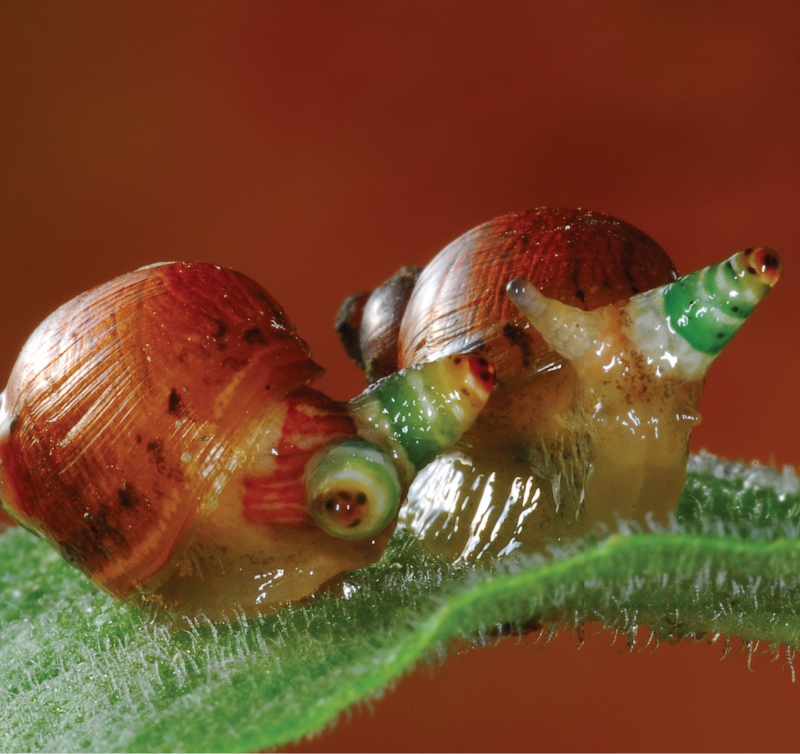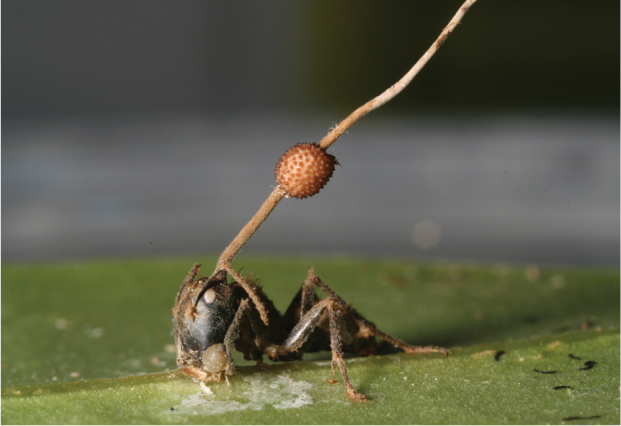Chapter 15
Parasitism and Infectious Diseases
342

343
CHAPTER CONCEPTS
- Many different types of parasites affect the abundance of host species.
- Parasite and host dynamics are determined by the parasite’s ability to infect the host.
- Parasite and host populations commonly fluctuate in regular cycles.
- Parasites have evolved offensive strategies while hosts have evolved defensive strategies.
The Life of Zombies
Zombie films scare us because they depict zombies as the walking dead in search of victims they will turn into more zombies. But something similar to this happens commonly in nature; some species of parasites infect a host and take control of its life for their own benefit.
“The ability of parasites to act as puppet masters over the behavior of their victims is just one way that parasites have evolved to improve their fitness.”
Consider the case of the amber snail (Succinea putris) from Europe. This animal lives along the edges of streams and ponds. It normally spends its time in the shade of terrestrial vegetation where it chews on leaves and remains hidden from the eyes of predatory birds. An amber snail will occasionally consume bird feces, which sometimes contain the eggs of a parasitic flatworm (Leucochloridium paradoxum). These eggs hatch inside the snail and grow, but to reproduce, the parasites must spend the next stage of their lives inside a bird. To achieve this goal, the larvae slowly make their way into the snail’s eyestalks. These eyestalks are normally pale and slender, but the parasitic infection causes the eyestalks to become enlarged and banded with colors that pulsate in a way that resembles a moving caterpillar. The parasites also take control of the snail’s brain and force the snail to move up a plant’s stem, which is not something an amber snail normally does. Snails that move up plant stems are more easily noticed by predatory birds and, because the eyestalks look like caterpillars, birds consume the infected snails. The parasite completes the second stage of its life inside the bird and the cycle continues. The flatworm reproduces, its eggs leave the bird through feces, and snails consume them.

Parasites can control the behavior of many different animals. In Thailand, for example, carpenter ants (Camponotus leonardi) normally spend their time living in nests in the hot, dry rainforest canopy. Occasionally the carpenter ants travel from the canopy to the ground where they can be exposed to the spores of the fungus Ophiocordyceps unilateralis, the so-called zombie-ant fungus, before heading back up to their nests. An ant that is infected subsequently moves down to the humid, understory vegetation. It stops at about 25 cm above the ground in a place that many previously infected ants have also gone, known to researchers as the “ant graveyard.” Here it bites the underside of a leaf and maintains a death grip on a leaf vein as it dies. After the ant dies, the fungus grows a spore-producing structure out of the ant’s head and releases its spores into the environment.
This unusual ant behavior does not benefit the ant, but it greatly benefits the fungus. The higher humidity found lower in the rainforest is more suited to fungal growth than the drier conditions high in the canopy. Moreover, if the infected ant were to die in its nest in the canopy, its nest mates would remove the corpse before the fungus could grow the spore-producing structure that is critical to its reproduction.
344
The ability of parasites to act as puppet masters over the behavior of their victims is just one way that parasites have evolved to improve their fitness. As we will discover in this chapter, parasites come in a wide variety of forms and their effects on hosts can range from mild to lethal. Adaptations that enable parasites to infect hosts and adaptions that help hosts to resist infections by parasites offer intriguing insights into the strategies of parasite–host interactions.
SOURCES: S. B. Andersen et al., The life of a dead ant: The expression of an adaptive extended phenotype, American Naturalist 174 (2009): 424–433.
D. P. Hughes et al., Behavioral mechanisms and morphological symptoms of zombie ants dying from fungal infection, BMC Ecology 11 (2011): 13.
T. Lefevre, and F. Thomas, Behind the scene, something else is pulling the strings: Emphasizing parasitic manipulation in vector-borne diseases, Infection, Genetics and Evolution 8 (2008): 504–519.
 The struggle between parasites and hosts has produced many fascinating examples of ecological interactions and evolutionary adaptations. In Chapter 1, we defined a parasite as an organism that lives in or on another organism, called the host, and causes harmful effects as it consumes resources from the host. Some hosts have infection resistance, which is the ability of a host to prevent the infection from occurring, while other hosts have infection tolerance, which is the ability of a host to minimize the harm that an infection can cause. The number of parasites of a given species that an individual host can harbor is known as the host’s parasite load. A parasite typically has only one or a few species of hosts, although a given host could contain dozens of species of parasites. In fact, it is estimated that approximately half of all species on Earth are parasites.
The struggle between parasites and hosts has produced many fascinating examples of ecological interactions and evolutionary adaptations. In Chapter 1, we defined a parasite as an organism that lives in or on another organism, called the host, and causes harmful effects as it consumes resources from the host. Some hosts have infection resistance, which is the ability of a host to prevent the infection from occurring, while other hosts have infection tolerance, which is the ability of a host to minimize the harm that an infection can cause. The number of parasites of a given species that an individual host can harbor is known as the host’s parasite load. A parasite typically has only one or a few species of hosts, although a given host could contain dozens of species of parasites. In fact, it is estimated that approximately half of all species on Earth are parasites.
When parasites cause an infectious disease, we call them pathogens. However, infection by a pathogen does not always result in a disease. For example, humans can be infected with human immunodeficiency virus (HIV) but they may never experience the disease symptoms known as Acquired Immune Deficiency Syndrome (AIDS). In many cases, it is not known what causes a host to transition from being infected by a pathogen to experiencing the disease.
Infectious diseases take a large toll on people; the World Health Organization estimates that more than 25 percent of all human deaths are caused by infectious diseases. Note that only infectious diseases are caused by pathogens; there are many noninfectious diseases in which pathogens do not play a role.
In this chapter, we will focus on the interaction between parasites and their hosts. In later chapters, we will discuss the larger role that parasites can play in communities and ecosystems. We will begin by looking at the many different types of parasites that exist, including those that have large effects on ecological communities, crops, domesticated animals, and human health. We will then examine the factors that determine whether parasites can infect hosts, spread rapidly through a population, and cause widespread harmful effects. Because mathematical models can help us understand the population dynamics of interacting species, we will also discuss parasite–host models. Finally, we will consider how parasites have evolved to increase their chances of infecting hosts, and how hosts have evolved to combat the risk of infection.